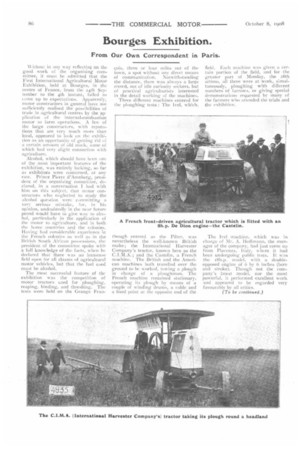Bourges Exhibition.
Page 6

If you've noticed an error in this article please click here to report it so we can fix it.
From Our Own Correspondent in Paris.
Without in any way reflecting on the good work of the organising committee, it mut4 be admitted that the First International Agricultural Motor Exhibition, held at Bourges, in the centre of France, from the 241h September to the 4th instant, failed to t otne up to expectations. Apparently, motor constructors in general have not sufficiently realised the possibilities of trade in agricultural centres by the application of the internal-combustion motor to farm operations. A few of the large constructors, with reputations that are very much more than local, appeared to look on the exhibition as an opportunity of getting rid ef • a certain amount of old stock, some of which had very slight connection with agriculture.
Alcohol, which should have been one of the most important features of the exhibition, was entirely lacking, so far as exhibitors were concerned, at any rate. Prince Pierre d'Arenberg, president of the organising committee, declared, in a conversation I had with him on this subject, that motor constructors who neglected to study the alcohol question were COII1T11 itting very serious mistake, for, in his opinion, undoubtedly in the near future petrol would have to give way to alcohol, particularly in the application of the motor to agriculture, and in both the home countries and the colonies. Haying had considerable experience in the French colonies as well as in the British South African possessions, the president of the committee spoke with a full knowledge of the facts, when he declared that there was an immense field open for all classes of agricultural motor vehicles, but that the fuel used must be alcohol.
The most successful feature of the exhibition was the conipetition of motor tractors used for ploughing, reaping, binding, and threshing. The tests were held on the Grange Fran
cois, three or four miles out of the town, a spot without any direct means of communication. Notwithstanding the distance, there was always a large crowd, not of idle curiosity seekers, but of practical agriculturists interested in the detail working of the machines. Three different machines entered for the ploughing tests : The Ivel, which, though entered as the Filter, was nevertheless the well-known British make; the International Harvester Company's tractor, known here as the C.I.M.A.; and the Castelin, a French machine. The British and the American machines both travelled over the ground to be worked, towing a plough in charge of a ploughman. The French machine remained stationary, operating its plough by means of a couple of winding drums, a cable • and a fixed point at the opposite end of the
field. Each machine was given a certain portion of the field, and for the greater part of Monday, the 28th ultimo, all three were at work, simultaneously, ploughing with different numbers of furrows, or giving special demonstrations requested by many of the farmers who attended the trials and the exhibition.
The Ivel machine, which was in charge of Mr. A. Hoffmann, the manager of the company, had just come up from Piacenza, Italy, where it had been undergoing public tests. It was the -18.h.p. model, with a doubleopposed engine of 6 by 6 inches (bore and stroke). Though not the company's latest model, nor the most powerful, it performed excellent work and appeared to be regarded very favourably by all critics.


















